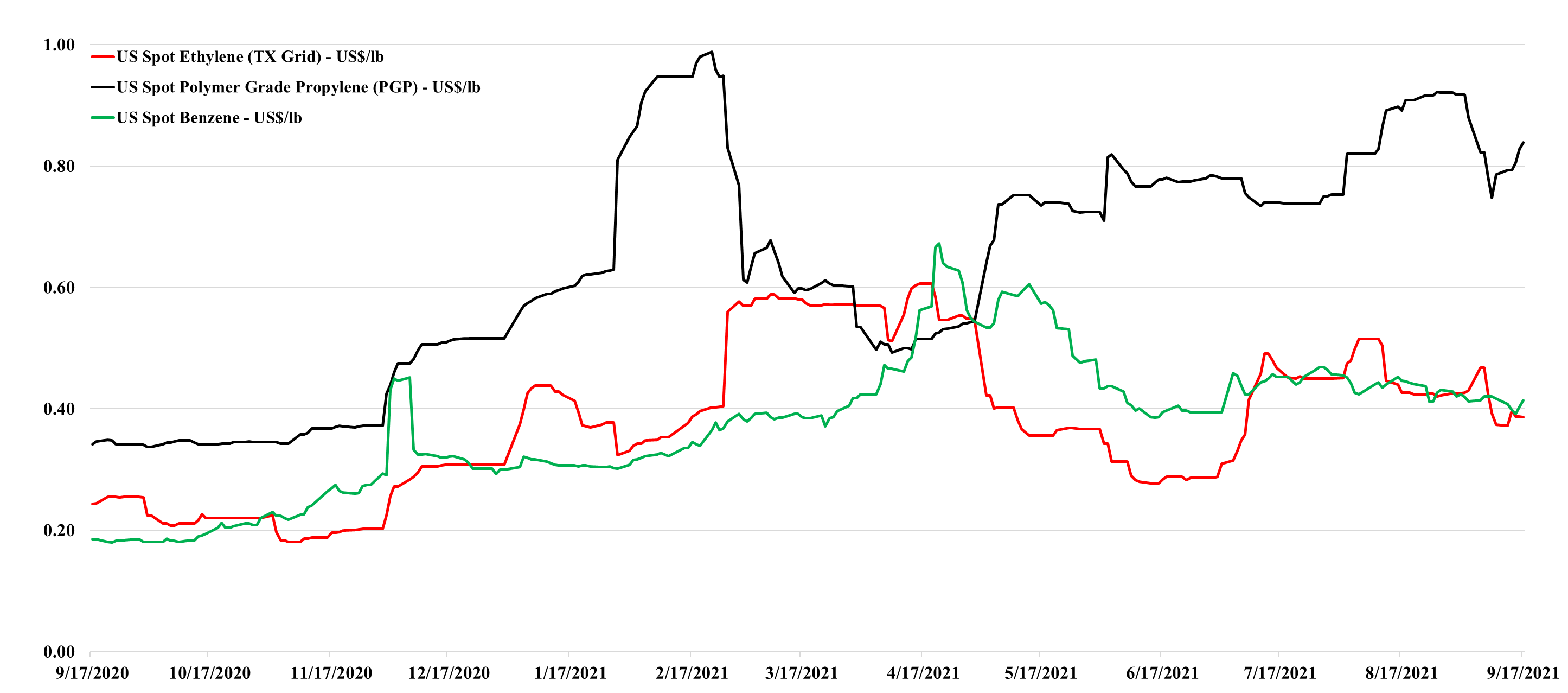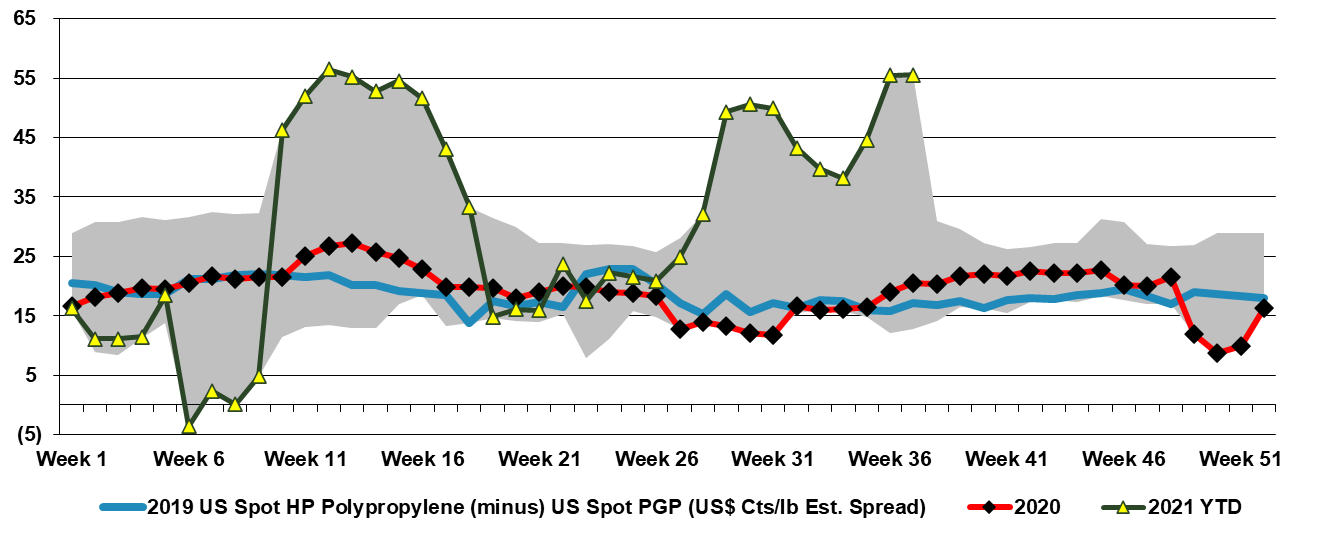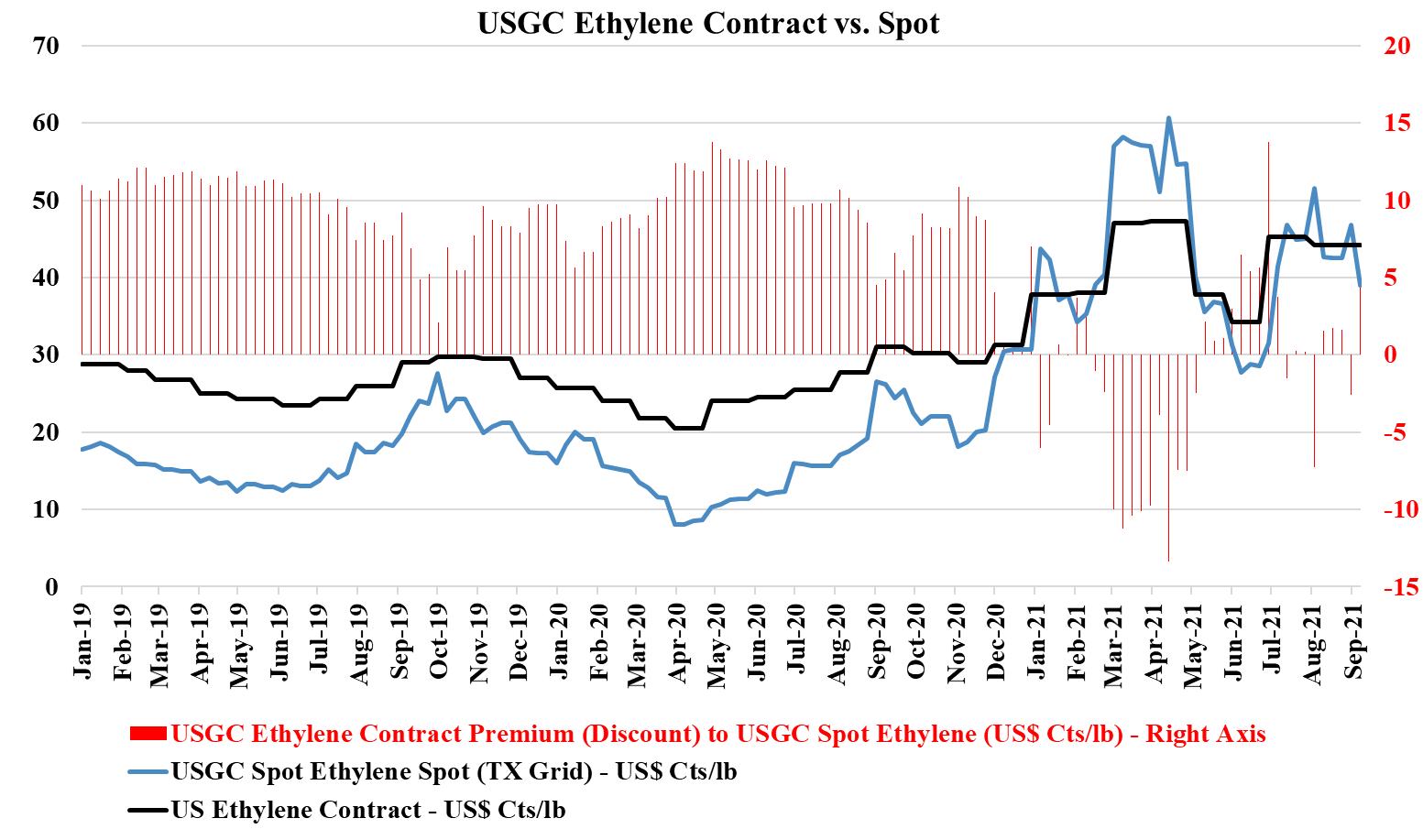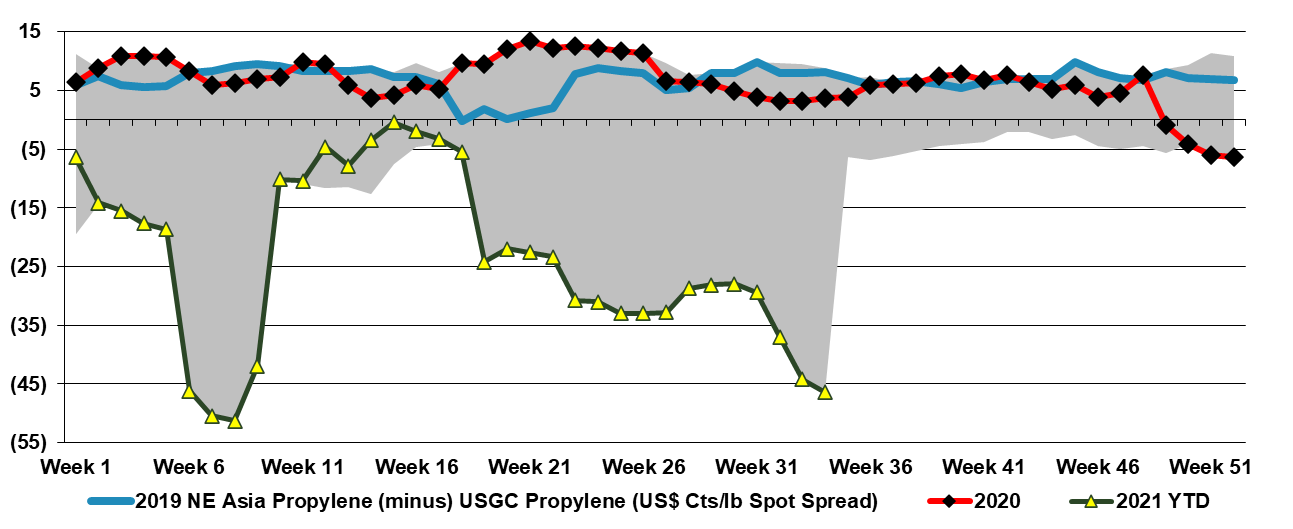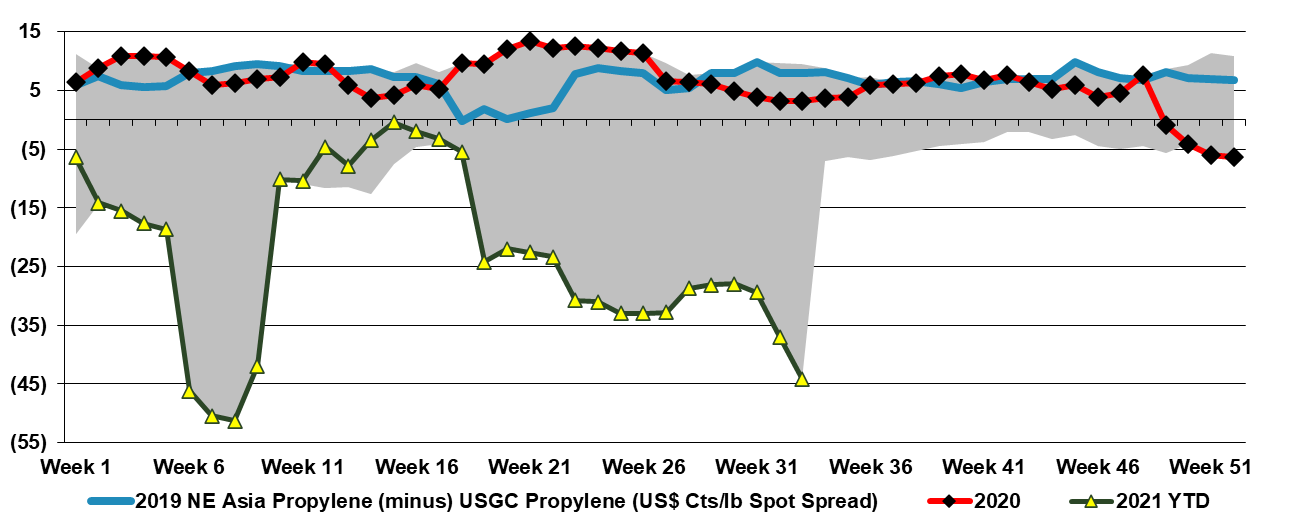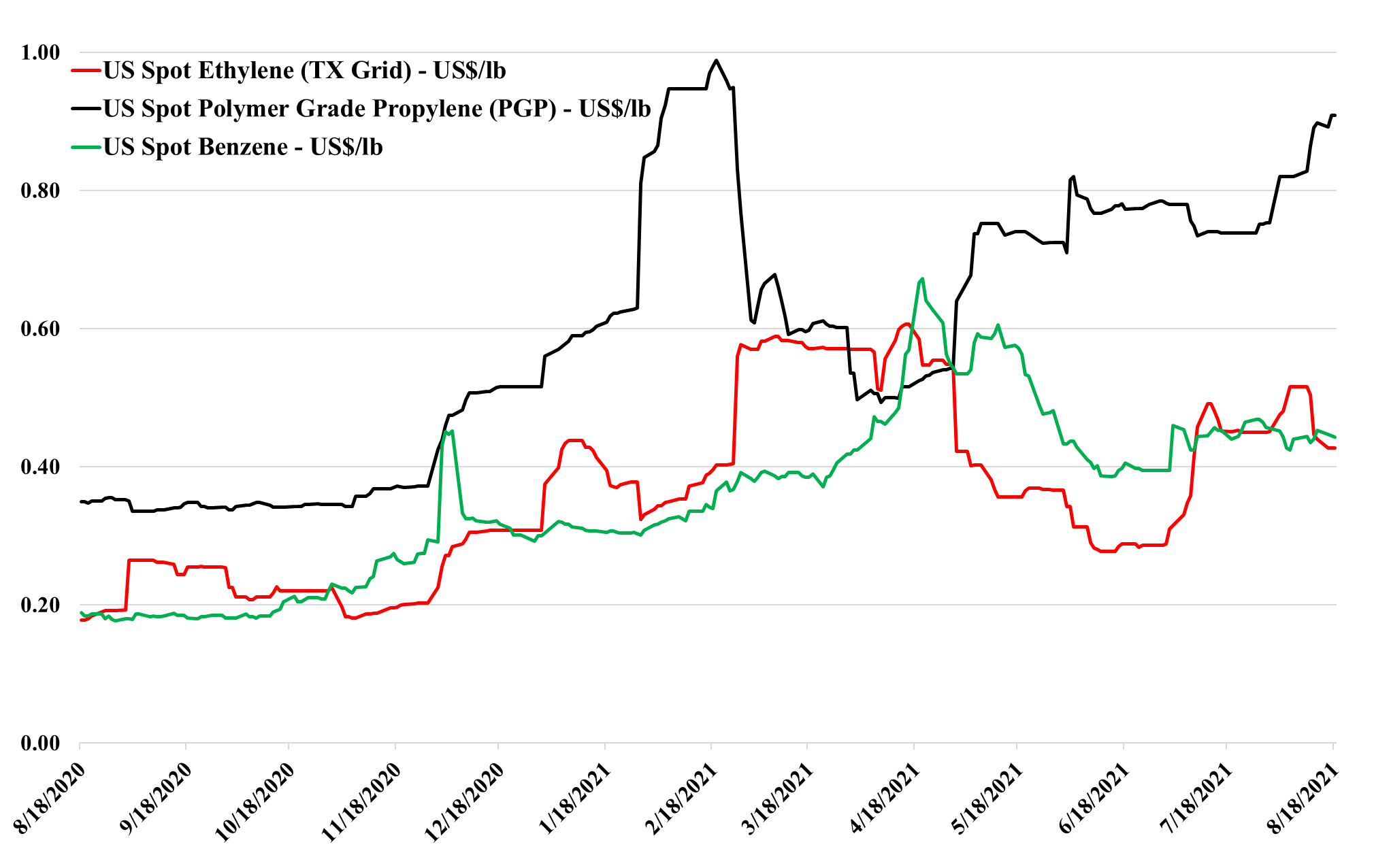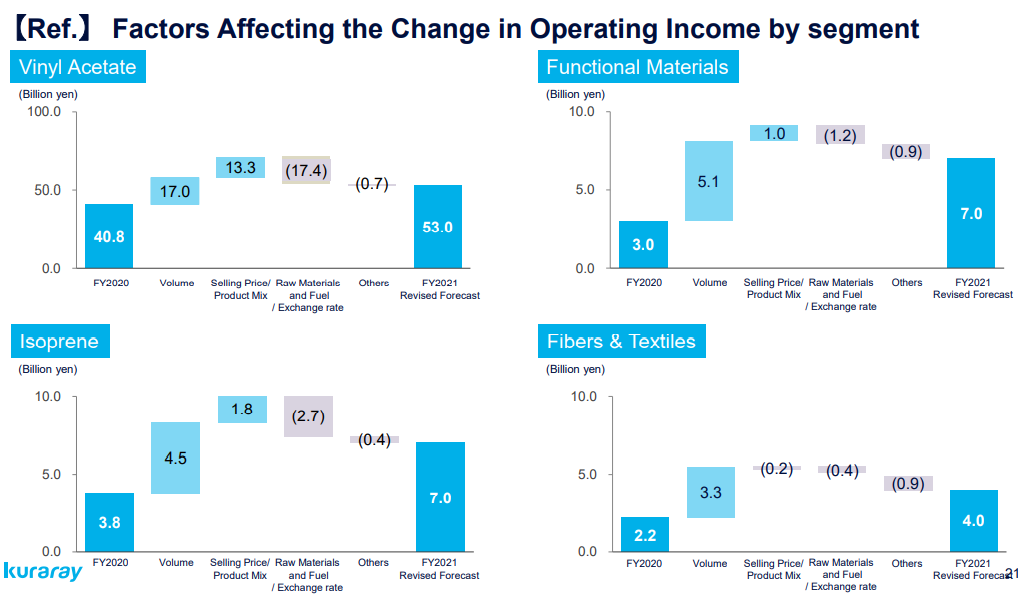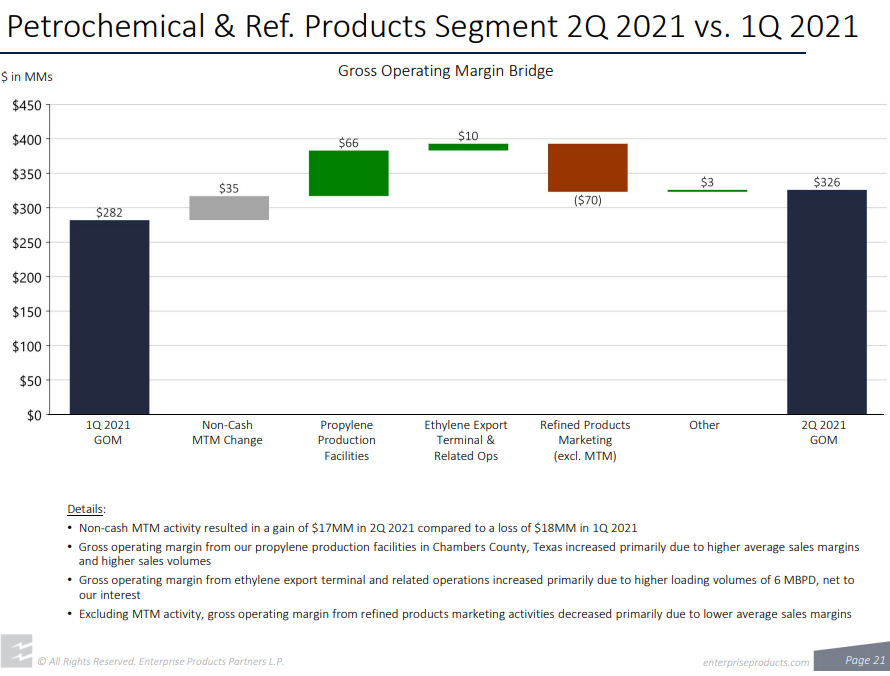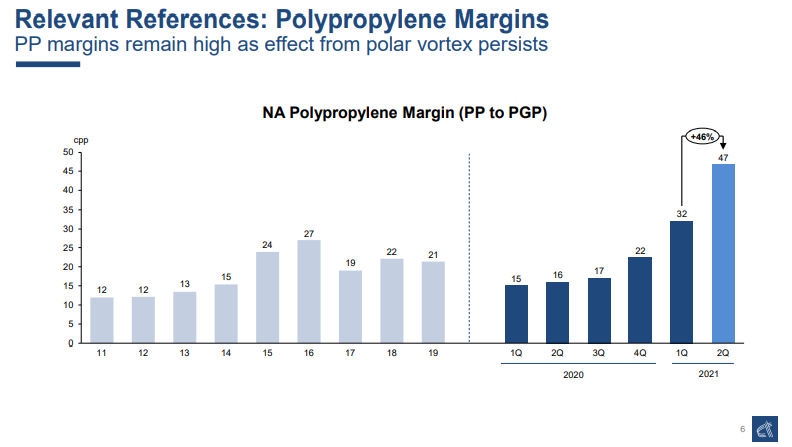We continue to see significant volatility in US product prices, and this increases uncertainty around the underlying direction of the markets for the balance of the year. The recent storms have likely created enough production interruptions to take any slack that had been developing in August out of play, and while we see that in the most recent moves for ethylene and propylene – Exhibit below - it is likely more interesting to see what happens with polymer pricing as we move through the balance of September – as this will determine profits for most. While we focus on the high prices in the US more than we do the prices in Europe, it is also worth noting that European polyolefin margins remain very high, with one local producer confirming this week that records continue to be set in terms of cash flows and unit profitability. The frustration for the US producers impacted by the storm is that while their plant closures may be contributing to the tight markets, they do not get the benefit of the higher margins on the impacted facilities. While we would expect many to produce extremely high numbers for 3Q – a handful will likely lament how much they could have made had their plants operated fully. See more in today's daily report.
Volatile Pricing Obscures Underlying Direction For Chemicals & Plastics
Sep 17, 2021 12:40:41 PM / by Cooley May posted in Chemicals, Polymers, Polyolefins, Propylene, Plastics, Ethylene, polymer pricing, volatility, US producers
How Durable Is Polypropylene?
Sep 15, 2021 12:22:50 PM / by Cooley May posted in Chemicals, Propylene, Polypropylene, Surplus, propane, polymer, propane prices, polymer market, ethylene feedstocks, US polypropylene
The crack in US polypropylene prices is probably worth some comments as the polymer has shown extraordinary strength since the middle of last year, in the face of new capacity that was expected to push the US market into surplus. In the chart below we show that the spread over propylene has not fallen, but this is because propylene is falling lock-step with polypropylene for the most part. Those companies integrated back to PDH economics will see a significant margins squeeze as polymer prices fall while propane prices increase. We have written recently about a concern that lower auto production rates in the US will back up into parts and that this will impact materials. In the early days of the auto cutbacks, we assumed that the automakers and their suppliers would simply build inventory, with the expectation of a bounce-back in demand once the chip shortage was over. As the chip shortage has dragged on and become more significant, we have likely hit any limit of inventory build, and we are concerned that polypropylene pricing could collapse if auto-related demand does not recover quickly. While autos are not a dominant demand category for polypropylene the sector is certainly large enough to swing the polymer market from shortage to surplus. With the rise in propane prices and other ethylene feedstocks, polypropylene profits could fall meaningfully. See today's daily for more comments on the propane markets.
US Monomer Prices Falling, But Weather Remains A Risk
Sep 9, 2021 4:03:52 PM / by Cooley May posted in Chemicals, Polymers, Propylene, Ethylene, PGP, ethylene producers, US ethylene, Propylene Derivatives, US propylene, Hurricane Ida
We saw the stable to downward trends in both US ethylene and propylene spot prices reverse at the end of 2020, in part because of recovering demand post the initial wave of COVID, but also because of storm-related production constraints in October and early November. The weaker spot markets for both ethylene and propylene today reflect much stronger production for propylene (all PDH capacity running) and Hurricane Ida-related upsets that have left the monomer markets less badly impacted than derivatives. Something similar happened in 2020, especially for ethylene, but the backlog of derivative demand cause a step up in ethylene consumption when everything restarted. This could happen again, and we are earlier in the Hurricane season. See today's daily report for more.
Propane: Pricing Itself Out Of The Chemical Feedstock Market
Sep 8, 2021 2:35:28 PM / by Cooley May posted in Chemicals, Propylene, supply and demand, propane, feedstock, propane prices, feedstock market
It will be interesting to see how US propane prices track this winter as we have low inventories in the US and there will likely be a step up in year-on-year export demand because of investments in Asia to consume imported propane. At some prices level, there will be demand destruction as ethylene and propylene economics are close to break-even in Asia and the region looks over-supplied enough for some producers to consider cutting back or even shutting down – if propane is the least attractive feedstock then the propane-based units will close first. Those producers in the US that have propane flexibility are unlikely to be anywhere near the market today as declining propylene prices in the US only make the feedstock less attractive. We wonder whether some of the traditional propane users in the US Gulf are experimenting with light naphtha/condensate as an alternative, but these feedstocks will also become less attractive as propylene prices fall. See more in today's daily report.
The Tale Of Two Regions: Asia Loose, US Tight
Aug 26, 2021 12:49:40 PM / by Cooley May posted in Chemicals, Polymers, Polyolefins, Propylene, Styrene, PET, Surplus, polymer producers, US Polymers
China trade data for chemicals and polymers points to a dramatic swing in net imports, partly due to the new capacity added over the last 12 months. Imports are down, and exports are up. Despite the logistic challenges of moving the products and the powerful pull on consumer durables from China driven by US and European demand – much of which consume significant volumes of polymers and chemicals locally. The trade swings talk to the significant capacity additions and the relatively sluggish consumer within China, where spending patterns remain subdued because of the Pandemic. Even with a recovery in domestic spending, China has probably added 2 to 3 years of demand growth in current capacity adds – most notably for polyolefins and PET, but also for styrene, where we believe demand growth could be slowing. If logistics improve and container rates come down, the surpluses in China will have a severe negative impact on international prices. This development will likely be seen in either polymer quantities flowing faster/more freely around the globe or because the export rate of consumer durables will pick up even further at the expense of durable producers in the US and Europe.
Reasons To Short US Propylene Mount! (If Able To Push Recent History Aside)
Aug 19, 2021 12:32:30 PM / by Cooley May posted in Chemicals, Propylene, propane, PGP, US propylene
The propylene charts in today's daily and below, show the extreme nature of the US market today – both relative to costs and prices internationally. Despite the very high cost of propane, the US propylene price is high enough to justify shipping propane to Asia – running it through local PDH capacity and shipping the propylene back to the US! This is the definition of unstable, but the logistics would be a constraint as the US does not have ship-based LPG import capability whee it would be needed. While we think propylene (polymer grade) is a compelling “short”, the markets over the last year have been so volatile and unpredictable and the US Hurricane season is far from over, so we would likely not put our money at risk today.
Could Propylene Lose Market Share To Ethylene?
Aug 18, 2021 12:28:03 PM / by Cooley May posted in Chemicals, Propylene, Ethylene, propane, Propylene Derivatives, exports
Propylene prices are rising again in the US, in part because of the propane price increase discussed in today's daily, but also because of reduced availability from other sources. These higher prices maintain upward pressure on propylene derivative pricing and we have to question how markets will adapt to much higher propylene and derivative pricing than ethylene and derivatives. There are several areas of potential overlap, where ethylene derivatives could take share from propylene derivatives and if the price deltas remain high and users become convinced that this could be the norm, it is reasonable to expect that propylene demand growth slows incrementally and ethylene demand growth benefits. In the immediate term, some quick switches could happen, but just as propylene demand marched ahead in the 1990s and 2000s because investments were made to use propylene derivatives instead of ethylene derivatives, we could begin to see investment to reverse the process. This was an incremental process for propylene over decades and we would not expect to see anything less incremental in the other direction, but ultimately this could be good for the more focused US ethylene and derivative markets if it accelerates growth in onshore demand and decreases the reliance on exports.
Operating Leverage Spurs Downstream Profits, Combats Raw Material Cost Inflation
Aug 12, 2021 2:15:14 PM / by Cooley May posted in Chemicals, Propylene, Raw Materials, raw materials inflation, downstream, Basic Chemicals, Kuraray, specialty chemicals, commodity prices, basic chemical markets, commodity producers
The 2Q volume driver of Kuraray’s earnings recovery was substantial, partly because end-market demand is strong and because this more mid-stream and specialty portfolio has significant operating leverage, much more than you would see from the commodity producers. We find this as a notable downstream sector trend to keep in mind. As seen below, increased selling prices are an important driver of Kuraray full-year profit growth expectations, but the volume piece is the most critical component, in our view. As discussed in our daily report today available in LINK, we continue to see volatile but elevated basic chemical prices.
Propylene: Market Tightness and Derivatives Momentum
Jul 28, 2021 12:57:41 PM / by Cooley May posted in Chemicals, Propylene, petrochemicals, Propylene Derivatives, Enterprise Products, PDH
The Enterprise Products propylene numbers are impressive when you considering that its PDH facility was closed for a significant portion of the quarter, and while this likely contributed to tightness in the market, the company could have made even more money in 2Q. The results show the clear tightness in the propylene market in the US and reflect the very strong momentum in propylene derivatives, which is broad-based although we have tended to focus on polypropylene in recent work. See more in today's daily report.
Great North American Polypropylene Margins Despite New Capacity
Jul 22, 2021 12:07:14 PM / by Cooley May posted in Chemicals, Propylene, Polypropylene, Supply Chain, Capacity, cyclical demand, polypropylene margins, Braskem
The much higher polypropylene margins in the US come despite very high propylene pricing, and the whole chain did well in the first half of the year. Demand for polypropylene has been significantly stronger than most expected year to date, although production outages have helped the market, and what we had expected to be a surplus in the US in 2021, precipitated by the Braskem start-up has turned out to be production coming online just in time and prices might have been higher still had the Braskem plant not been there. We see some of the demand as cyclical - in response to consumer durables, though there has been lower use in the auto industry because of the production cutbacks. See more in today's daily report.


